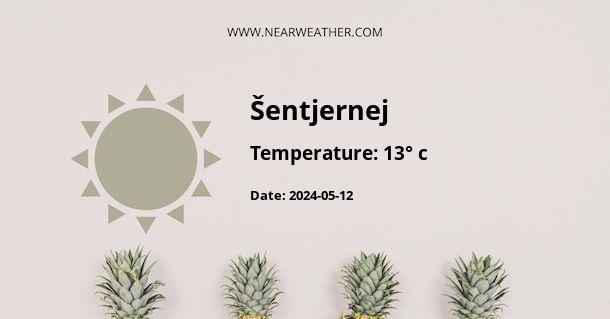Climate and Weather Overview in Šentjernej, Slovenia
Located in southeastern Slovenia, Šentjernej is a charming municipality that experiences a variety of climatic conditions throughout the year. Understanding the climate and weather of this area not only provides valuable information for residents and visitors alike but also reflects the broader European weather patterns. In this detailed examination, we will delve into the seasonal climate variations, temperature extremes, precipitation levels, and other meteorological aspects that define Šentjernej's weather year-round.
Geographical and Climatic Context
Šentjernej lies within the Dinaric Alps region, which heavily influences its climate. The municipality experiences a continental climate with oceanic influences due to its proximity to the Adriatic Sea. This hybrid climatic zone results in warm summers, cold winters, and precipitation throughout the year.
Seasonal Weather Patterns in Šentjernej
Spring
Spring in Šentjernej sees the transition from the chilly winter to the more temperate conditions of summer. The temperatures gradually increase, with an average daily temperature ranging from 5°C to 15°C. Precipitation during this period is moderate with occasional rain showers, marking the onset of the lush green scenery the region is known for.
Summer
The summer months bring about the warmest temperatures of the year with averages that fluctuate between 18°C and 28°C. These temperatures, coupled with the region's rich soil, contribute to Šentjernej's reputation for viticulture. The warmth, however, can bring thunderstorms, and July is considered the wettest month of the year for the region.
Autumn
Autumn signifies a time of change as the temperatures begin to cool. Average temperatures in Šentjernej range from 10°C to 20°C during this season. This cooling trend is accompanied by increased rainfall, which helps prepare the soil for the coming winter months.
Winter
Winter in Šentjernej is characterized by cold and often below freezing temperatures, particularly during January, the coldest month. Average temperatures range from -2°C to 3°C. Snowfall is common, providing picturesque landscapes but also challenging conditions for transportation and outdoor activities.
Temperature Extremes and Records
Historical temperature data for Šentjernej has shown significant extremes, reflecting the continental influences on the local climate. Recorded temperature highs have reached up to 35°C during heatwaves in the summer months, while winter lows have dropped to a frigid -15°C during cold spells.
Precipitation Levels
Precipitation in Šentjernej is relatively evenly distributed throughout the year, although there is a noticeable peak during the summer months as a result of convective rainfall from thunderstorms. The table below provides an overview of the average monthly precipitation levels.
| Month | Average Precipitation (mm) |
|---|---|
| January | 45 |
| February | 40 |
| March | 55 |
| April | 65 |
| May | 75 |
| June | 100 |
| July | 110 |
| August | 100 |
| September | 85 |
| October | 70 |
| November | 75 |
| December | 55 |
Wind and Atmospheric Patterns
Šentjernej's position in the Dinaric Alps means the area is subject to dynamic atmospheric patterns. The region is affected by several prevailing wind types including the cold, northeasterly bora wind in the winter, and the warm, southerly jugo wind in the autumn and spring. These winds not only influence the temperature but also play a role in the distribution of precipitation across the region.
Air Quality and Climate Concerns
The air quality in Šentjernej is typically good, due to the rural nature of the region and the lack of heavy industry. However, during winter, air quality can decrease somewhat due to particulate matter from wood-burning stoves used for heating. Moreover, concerns about climate change and its potential impact on weather patterns, like increased severe weather events and changes in precipitation, loom large for the area.
Climate Adaptation and Sustainability Efforts
In the wake of the growing concern over climate change, Šentjernej and Slovenia as a whole have started to implement sustainability initiatives. These efforts are aimed at reducing carbon emissions and promoting renewable energy sources. For instance, investment in hydroelectric facilities and solar power plants in the region are steps towards a more sustainable and environmentally-friendly future for Šentjernej.
Expert Opinions and Research
- Meteorologists emphasize the need for continued research into the regional impacts of climate change, particularly as they pertain to agricultural practices in Šentjernej.
- Climatologists have noted the potential for increased variability in weather patterns, including more frequent and intense heatwaves and storms.
- Environmentalists stress the importance of preserving the natural landscapes and biodiversity of the region, which play a crucial role in maintaining the local microclimate.
Conclusion
Šentjernej's climate and weather offer a microcosm of the larger European climate dynamics. From its moderate spring weather to hot summers, the municipality is a prime example of the continental climate with oceanic influences. The diverse weather patterns, coupled with the town's commitment to adapting to and mitigating climate change, make Šentjernej a unique location both climatically and culturally.
A - Šentjernej's Latitude is 45.840000 & Longitude is 15.336110.
A - Weather in Šentjernej is 6° today.
A - Climate Conditions in Šentjernej shows few clouds today.
A - Humidity in Šentjernej is 81% today.
A - Wind speed in Šentjernej is 18.5 km/h, flowing at 250° wind direction. today.
